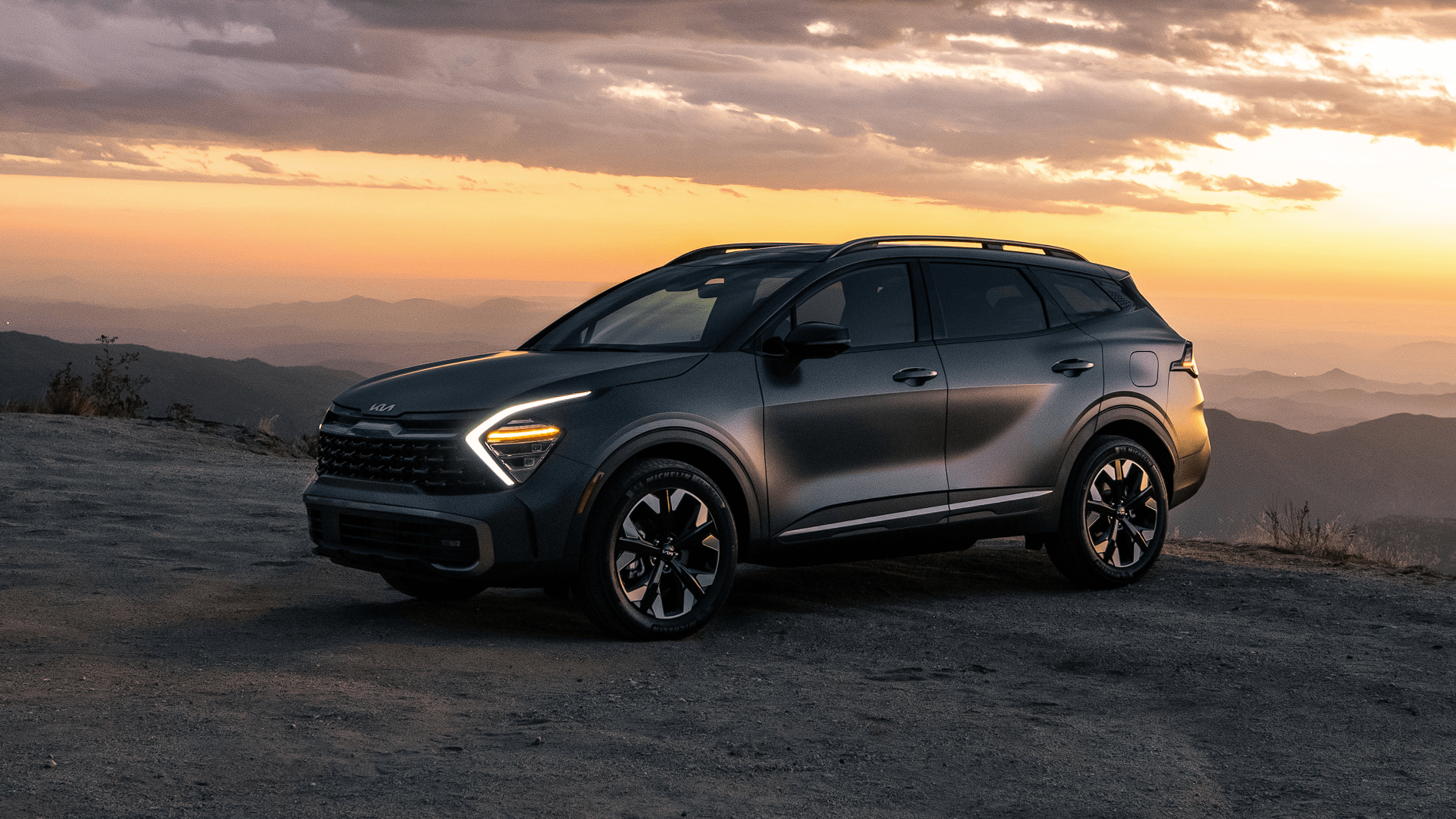Kia Sportage PHEV 2023 Forward Collision-Avoidance Assist (FCA) (Sensor Fusion)
The 2023 Kia Sportage PHEV is a big step forward in environmentally friendly and safety-focused car design, especially with its cutting-edge Forward Collision-Avoidance Assist system that uses cutting-edge Sensor Fusion technology. This amazing hybrid SUV not only embraces the future of environmentally friendly transportation with its plug-in hybrid electric engine, but it also shows Kia’s unwavering dedication to making roads safer with its cutting-edge sensor fusion features. By seamlessly combining many sensors and data sources, the Sportage PHEV’s Forward Collision-Avoidance Assist system not only sees potential dangers on the road but also acts quickly and precisely to avoid accidents, setting a new standard for both safety and environmental friendliness in cars after 2023.
2023 KIA SPORTAGE Specs, Price, Features and Mileage (Brochure)
Forward Collision-Avoidance Assist (FCA) (Sensor Fusion)
Basic function
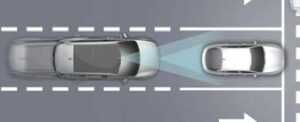
Forward Collision-Avoidance Assist is designed to help detect and monitor the vehicle ahead or help detect a pedes-trian or cyclist in the roadway and warn the driver that a collision is imminent with a warning message and an audible warning, apply emergency braking.
Junction Turning function
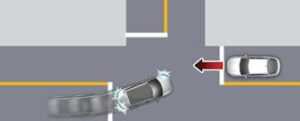
The Junction Turning function will help avoid a collision with an oncoming vehicle in an adjacent lane when turning left at a crossroad with the turn signal on by applying emergency braking.
Detecting sensor
Front view camera
Front radar
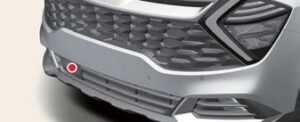
Refer to the picture above for the detailed location of the detecting sensors.
CAUTION
- Never disassemble the detecting sensor or sensor assembly, or apply any impact on it.
- If the detecting sensors have been replaced or repaired, have the vehicle inspected by an authorized Kia dealer.
- Never install any accessories or stickers on the front windshield, or tint the front windshield.
- Pay extreme caution to keep the front view camera dry.
- Never place any reflective objects (i.e. white paper, mirror) over the dashboard.
- Do not apply license plate frame or objects, such as a bumper sticker, film or a bumper guard, near the front radar cover.
- Always keep the front radar and cover clean and free of dirt and debris. Use only a soft cloth to wash the vehicle. Do not spray pressurized water directly on the sensor or sensor cover.
- If unnecessary force has been applied to the radar or around the radar, For-ward Collision-Avoidance Assist may not properly operate even though a warning message does not appear on the cluster. Have the vehicle inspected by an authorized Kia dealer.
- Use only genuine parts to repair or replace a damaged front radar cover. Do not apply paint to the front radar cover.
Forward Collision-Avoidance Assist settings
Setting features
Forward Safety
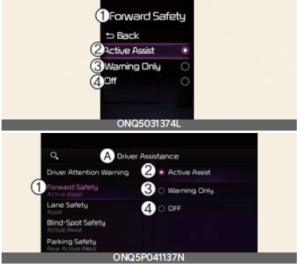
A: Driver Assistance
- Forward Safety
- Active Assist
- Warning Only
- Off
With the vehicle on, select Setup → Driver Assistance → Forward Safety from the User Settings menu or select Setup → Vehicle → Driver Assistance Forward Safety from the infotainment system to set whether or not to use each function.
- Active Assist: Forward Collision Avoidance Assist will warn the driver with a warning message, and an audible warning depending on the collision risk levels. Braking assist will be applied depending on the collision risk.
- Warning Only: Forward Collision- Avoidance Assist will warn the driver with a warning message, and an audible warning depending on the collision risk levels. Braking will not be assisted. The driver must apply the brake pedal or steer the vehicle if necessary.
- Off: Forward Collision-Avoidance Assist will turn off. The warning light ( ) will appear on the cluster.
The driver can monitor Forward Collision-Avoidance Assist ON/OFF status from the Settings menu. If the warning light ( ) remains ON when Forward Collision-Avoidance Assist is ON, have the vehicle inspected by an authorized Kia dealer.
WARNING
When the vehicle is restarted, Forward Collision-Avoidance Assist will always turn on. However, if Off is selected, the driver should always be aware of the surroundings and drive safely.
CAUTION
- If Warning Only is selected, braking is not assisted.
- The settings for Forward Safety include ‘Basic function’ and ‘Junction Turning’.
NOTICE
Forward Collision-Avoidance Assist will turn off when ESC is turned off by pressing and holding the ESC OFF button. The warning light ( ) will appear on the cluster.
Warning Timing
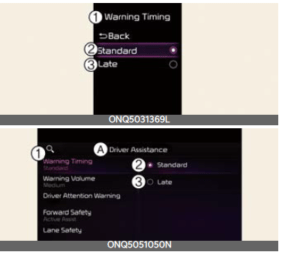
A: Driver Assistance
- Warning Timing
- Standard
- Late
With the vehicle on, select Setup → Driver Assistance → Warning Timing from the User Settings menu or select Setup → Vehicle → Driver Assistance Warning Timing from the infotainment system to change the initial warning activation time for Forward Collision-Avoidance Assist.
- Standard: Use in a normal driving environment. If the function operates too sensitively, set to the warning timing to Late. environment. If the function operates too sensitively, set to the warning timing to Late.
- Late: The warning timing will be slow.
Warning Volume
A: Driver Assistance
- Warning Volume
- High
- Medium
- Low
With the vehicle on, select Setup → Driver Assistance → Warning Volume from the User Settings menu or select Setup → Vehicle → Driver Assistance Warning Volume from the infotainment system to change the Warning Volume to High, Medium, or Low for Forward Collision-Avoidance Assist.
CAUTION
- The setting of the Warning Timing and Warning Volume applies to all functions of Forward Collision-Avoidance Assist.
- Even though Standard is selected for Warning Timing, if the front vehicle suddenly stops, the initial warning activation time may seem late.
- Select Late for Warning Timing when traffic is light and when driving speed is slow.
NOTICE
- If the vehicle is restarted, Warning Timing and Warning Volume will maintain the last setting.
- If you change the Warning Volume, the warning volume of other Driver Assistance systems may change.
Forward collision avoidance Assist operation
Basic function
The basic function for Forward Collision-Avoidance Assist is warned and controlled by the following level.
- Collision Warning
- Emergency Braking
- Stopping vehicle and ending the brake control
Collision Warning

A: Collision Warning
The warning message and an audible warning will warn the driver of a collision.
Collision Warning will be activated at the following speed of your vehicle, depending on the object.
- For Vehicle: 3~112 mph (5~180 km/h)
- Pedestrian or cyclist: 3~53 mph (5~85
Emergency Braking
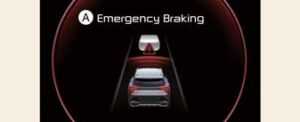
A: Emergency Braking
The warning message, and an audible warning will warn the driver that emergency braking will be assisted. The brake assist will be activated and it helps avoiding collision of a vehicle, pedestrian and cyclist.
Emergency Braking will be activated in following speed of your vehicle, depending on the object.
- For Vehicle: 3~53 mph (5~85 km/h)
- For Pedestrian or cyclist: 3~40 mph (5~65 km/h)
Stopping vehicle and ending the brake control

A: Drive carefully
When the vehicle is stopped due to emergency braking, the warning message will appear on the cluster. For your safety, the driver should depress the brake pedal immediately and check the surroundings.
- Brake control will end after the vehicle is stopped by emergency braking for approximately 2 seconds.
Junction Turning function
Warning and Control
The basic function for Junction Turning function is warned and controlled by the following level.
- Collision Warning
- Emergency Braking
- Stopping vehicle and ending brake control
Collision Warning
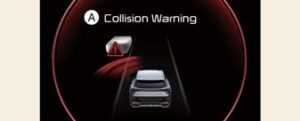
A: Collision Warning
The warning message, and an audible warning will warn the driver of a collision. Collision Warning will be activated in fol-lowing conditions.
- Vehicle speed: 4~19 mph (7~30 km/h)
- Oncoming vehicle speed: 15 ~ 44 mph (25 ~ 70 km/h)
Emergency Braking
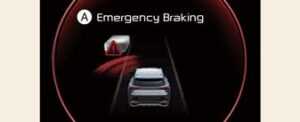
A: Emergency Braking
The warning message, and an audible warning will warn the driver that emergency braking will be assisted. The brake assist will be activated and it helps avoiding collision of a vehicle. Emergency Braking will be activated in following conditions.
- Vehicle speed: 4~19 mph (7~30 km/h)
- Oncoming vehicle speed: 15~44 mph (25~70 km/h)
Stopping vehicle and ending brake control
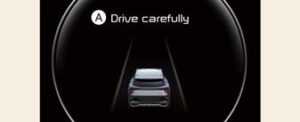
A: Drive carefully
When the vehicle is stopped due to emergency braking, the warning message will appear on the cluster. For your safety, the driver should depress the brake pedal immediately and check the surroundings.
- Brake control will end after the vehicle is stopped by emergency braking for approximately 2 seconds.
CAUTION
If the driver’s seat is on the left side, Junction Turning function will operate only when the driver turns left. If the driver’s seat position is on right side, the function will operate only when you turn right.
WARNING
- For your safety, change the Settings after parking the vehicle at a safe location.
- With Active Assist or Warning Only selected, when ESC is turned off by pressing and holding the ESC OFF button, Forward Collision-Avoidance Assist will turn off automatically. In this case, Forward Collision-Avoidance Assist cannot be set from the Settings menu and the ( ) warning light will appear on the cluster which is normal. If ESC is turned on by pressing the ESC OFF button again, Forward Collision-Avoidance Assist will maintain the last setting.
- Forward Collision-Avoidance Assist does not operate in all situations or cannot avoid all collisions.
- The driver should hold the responsibility to control the vehicle. Do not solely depend on Forward Collision-Avoidance Assist. Rather, maintain a safe braking distance, and if necessary, depress the brake pedal to reduce driving speed or to stop the vehicle.
- Never deliberately operate Forward b Collision-Avoidance Assist on people, objects, etc. It may cause serious injury or death.
- Forward Collision-Avoidance Assist may not operate if the driver depresses the brake pedal to avoid collision.
- Depending on the road and driving conditions, Forward Collision-Avoidance Assist may warn the driver late or may not warn the driver.
- During Forward Collision-Avoidance Assist operation, the vehicle may stop suddenly injuring passengers and shifting loose objects. Always have the seat belt on and keep loose objects secured.
- If any other function’s warning message is displayed or audible warning is generated, Forward Collision-Avoidance Assist warning message may not be displayed and audible warning may not be generated.
- You may not hear the warning sound
of Forward Collision-Avoidance Assist if the surroundings are noisy. - Forward Collision-Avoidance Assist may turn off or may not operate properly or may operate unnecessarily depending on the road conditions and the surroundings.
- Even if there is a problem with For-ward Collision-Avoidance Assist, the vehicle’s basic braking performance will operate normally.
- During emergency braking, braking control by Forward Collision-Avoidance Assist will automatically cancel when the driver excessively depresses the accelerator pedal or sharply steers the vehicle.
CAUTION
- Depending on the condition of the vehicle, pedestrian and cyclist in front and the surroundings, the speed range to operate Forward Collision-Avoidance Assist may reduce. For-ward Collision-Avoidance Assist may only warn the driver, or it may not operate.
- Forward Collision-Avoidance Assist will operate under certain conditions by judging the risk level based on the condition of the oncoming vehicle, driving direction, speed and surroundings.
NOTICE
- In a situation where collision is imminent, braking may be assisted by For-ward Collision-Avoidance Assist when braking is insufficient by the driver.
- The images or colors may be displayed differently depending on the specifications of the instrument cluster or theme.
Forward Collision-Avoidance Assist malfunction and limitations
Forward Collision-Avoidance Assist malfunction
A: Check Forward Safety system
When Forward Collision-Avoidance Assist is not working properly, the warning message will appear, and the ( ) and ( ) warning lights will appear on the cluster.
Forward Collision-Avoidance Assist disabled

A: Forward Safety system disabled. Radar blocked

A: Forward Safety system disabled. Camera obscured
When the front windshield where the front view camera is located, front radar cover, or sensor is located is covered with foreign material, such as snow or rain, it can reduce the detecting performance and temporarily limit or disable Forward Collision-Avoidance Assist.
If this occurs the warning message, and the ( ) and ( ) warning lights will appear on the cluster.
Forward Collision-Avoidance Assist will operate normally when snow, rain or foreign material is removed. Always keep it clean.
If Forward Collision-Avoidance Assist does not operate normally after obstruction (snow, rain, or foreign material) is removed, have the vehicle inspected by an authorized Kia dealer.
WARNING
- Even though the warning message or warning light does not appear on the cluster, Forward Collision-Avoidance Assist may not properly operate.
- Forward Collision-Avoidance Assist may not properly operate in an area (e.g. open terrain), where any sub-stance are not detected after turning ON the vehicle.
Limitations of Forward Collision-Avoidance Assist
Forward Collision-Avoidance Assist may not operate normally, or it may operate unexpectedly under the following circumstances:
- The detecting sensor or the surroundings are contaminated or damaged
- The temperature around the front view camera is high or low due to sur-rounding environment
- The camera lens is contaminated due to tinted, filmed or coated windshield, damaged glass, or sticky foreign material (sticker, bug, etc.) on the glass
- Moisture is not removed or frozen on the windshield
- Washer fluid is continuously sprayed, or the wiper is on
- Driving in heavy rain or snow, or thick fog
- The field of view of the front view camera is obstructed by sun glare
- Street light or light from an oncoming vehicle is reflected on the wet road surface, such as a puddle on the road
- An object is placed on the dashboard
- Your vehicle is being towed
- The surroundings are very bright
- The surroundings are very dark, such as in a tunnel, etc.
- The brightness changes suddenly, for example when entering or exiting a tunnel
- The brightness outside is low, and the headlamps are not on or are not bright
- Only part of the vehicle, pedestrian or cyclist is detected
- The vehicle in front is a bus, heavy truck, truck with a unusually shaped luggage, trailer, etc.
- The vehicle in front has no tail lights, tail lights are located unusually, etc.
- The brightness outside is low, and the tail lamps are not on or are not bright
- The rear of the front vehicle is small or the vehicle does not look normal, such as when the vehicle is tilted, over-turned, or the side of the vehicle is visible, etc.
- The front vehicle’s ground clearance is low or high
- A vehicle, pedestrian or cyclist suddenly cuts in front
- The bumper around the front radar is impacted, damaged or the front radar is out of position
- The temperature around the front radar is high or low
- Driving through a tunnel or iron bridge
- Driving in large areas where there are few vehicles or structures (i.e. desert, meadow, suburb, etc.)
- Driving near areas containing metal substances, such as a construction zone, railroad, etc.
- A material is near that reflects very well on the front radar, such as a guardrail, nearby vehicle, etc.
- The cyclist in front is on a bicycle made of material that does not reflect on the front radar
- The vehicle in front is detected late
- The vehicle in front is suddenly blocked by a obstacle
- The vehicle in front suddenly changes lane or suddenly reduces speed
- The vehicle in front is bent out of
- The front vehicle’s speed is fast or slow
- The vehicle in front steers in the opposite direction of your vehicle to avoid a collision
- With a vehicle in front, your vehicle changes lane at low speed
- The vehicle in front is covered with snow
- You are departing or returning to the lane
- Unstable driving
- You are on a roundabout and the vehicle in front is not detected
- You are continuously driving in a circle
- The vehicle in front has an unusual shape
- The vehicle in front is driving uphill or downhill
- The pedestrian or cyclist is not fully detected, for example, if the pedestrian is leaning over or is not fully walking upright
- The pedestrian or cyclist is wearing clothing or equipment that makes it difficult to detect as a pedestrian or cyclist
The illustration below shows the image the front view camera and front radar will detect as a vehicle, pedestrian and cyclist.
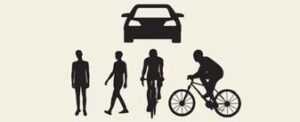
- The pedestrian or cyclist in front is moving very quickly
- The pedestrian or cyclist in front is short or is posing a low posture
- The pedestrian or cyclist in front has impaired mobility
- The pedestrian or cyclist in front is moving intersected with the driving direction
- There is a group of pedestrians, cyclists or a large crowd in front
- The pedestrian or cyclist is wearing clothing that easily blends into the background, making it difficult to detect
- The pedestrian or cyclist is difficult to distinguish from the similar shaped structure in the surroundings
- You are driving by a pedestrian, cyclist, traffic signs, structures, etc. near the intersection
- When driving in the following places
- Driving through steam, smoke or shadow
- Driving through a tunnel or iron bridge
- Driving in large areas where there are few vehicles or structures (i.e. desert, meadow, suburb, etc.)
- Driving in a parking lot
- Driving through toll gate, construction areas, partially paved roads, bumpy roads, speed bumps, etc.
- Driving near areas containing metal substances, such as a construction zone, railroad, etc.
- Driving on an incline road, curved road, etc.
- Driving through a roadside with trees or streetlights
- Driving through a narrow road where trees or grass are overgrown
- There is interference by electromagnetic waves, such as driving in an area with strong radio waves or electrical noise
- The adverse road conditions cause excessive vehicle vibrations while driving
- Your vehicle height is low or high due to heavy loads, abnormal tire pres-sure, etc.
WARNING
- Driving on a curved road
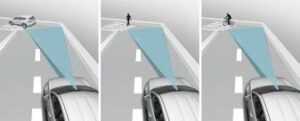
Forward Collision-Avoidance Assist may not detect other vehicle, pedestrian or cyclist in front of you on curved roads adversely affecting the performance of the sensors. This may result in no warning or braking assist when necessary. When driving on a curved road, you must maintain a safe braking distance, and if necessary, steer the vehicle and depress the brake pedal to reduce your driving speed in order to maintain a safe distance.

Forward Collision-Avoidance Assist may detect a vehicle, pedestrian or cyclist in the next lane or outside the lane when driving on a curved road.
If this occurs, Forward Collision-Avoidance Assist may unnecessarily warn the driver and control the brake. Always check the traffic conditions around the vehicle.
- Driving on a sloped road

Forward Collision-Avoidance Assist may not detect other vehicle, pedestrian or cyclist in front of you while driving uphill or downhill, adversely affecting the performance of the sensors.
This may result in unnecessary warning or braking assist or no warning or braking assist when necessary.
Also, vehicle speed may rapidly decrease when a vehicle, pedestrian or cyclist ahead is suddenly detected.
Always have your eyes on the road while driving uphill or downhill and if necessary, steer your vehicle and depress the brake pedal to reduce your driving speed in order to maintain a safe distance.
- Changing lanes
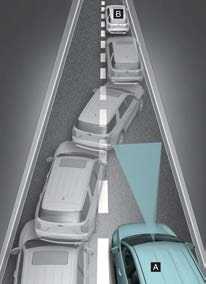
[A]: Your vehicle, [B]: Lane changing vehicle
When a vehicle (B) moves into your lane from an adjacent lane, it cannot be detected by the sensor until it is in the sensor’s detection range. Forward Collision-Avoidance Assist may not immediately detect the vehicle when the vehicle changes lanes abruptly. In this case, you must maintain a safe braking distance, and if necessary, steer your vehicle and depress the brake pedal to reduce your driving speed in order to maintain a safe distance.
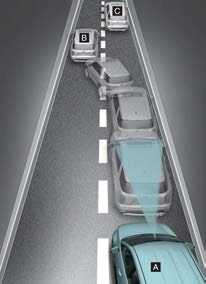
[A]: Your vehicle, [B]: Lane changing vehicle,
[C]: Same lane vehicle
When a vehicle (B) in front of you merges out of the lane, Forward Collision-Avoidance Assist may not immediately detect the vehicle (C) that is now in front of you. In this case, you must maintain a safe braking distance, and if necessary, steer your vehicle and depress the brake pedal to reduce your driving speed in order to maintain a safe distance.
- Detecting a vehicle
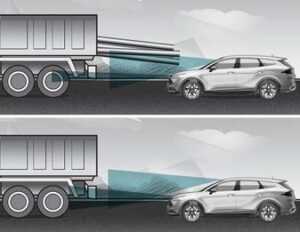
If the vehicle in front of you has cargo that extends rearward from the cab, or when the vehicle in front of you has higher ground clearance, additional special attention is required. Forward Collision-Avoidance Assist may not be able to detect the cargo extending from the vehicle. In these instances, you must maintain a safe braking distance from the rearmost object, and if necessary, steer your vehicle and depress the brake pedal to reduce your driving speed in order to maintain distance.
WARNING
- When you are towing a trailer or another vehicle, we recommend that Forward Collision-Avoidance Assist is turned off due to safety reasons.
- Forward Collision-Avoidance Assist may operate if objects that are similar in shape or characteristics to a vehicle, pedestrian or cyclist are detected.
- Forward Collision-Avoidance Assist does not operate on bicycles, motorcycles, or smaller wheeled objects, such as luggage bags, shopping carts, or strollers.
- Forward Collision-Avoidance Assist may not operate normally if interfered by strong electromagnetic waves.
- Forward Collision-Avoidance Assist may not operate for 15 seconds after the vehicle is started, or the front view camera is initialized.
This device complies with Part 15 of the FCC rules.
Operation is subject to the following three conditions:
- This device may not cause harmful interference, and
- This device must accept any interference received, including interference that may cause undesired operation.
- Changes or modifications not expressly approved by the party responsible for compliance could void the user’s authority to operate the device.
Radiofrequency radiation exposure information:
This equipment complies with FCC radiation exposure limits set forth for an uncontrolled environment. This equipment should be installed and operated with a minimum distance of 8 inches (20 cm) between the radiator (antenna) and your body. This transmitter must not be collocated or operating in conjunction with any other antenna or transmitter.
FAQ
Forward Collision-Avoidance Assist (Sensor Fusion) is an advanced safety feature in modern vehicles that utilizes a combination of sensors and cameras to monitor the road ahead. It’s designed to help prevent or mitigate collisions by detecting obstacles or vehicles in the vehicle’s path and taking action to avoid or reduce the severity of a potential collision.
Sensor Fusion combines data from multiple sensors and cameras, such as radar, lidar, and cameras, to provide a more accurate and comprehensive view of the vehicle’s surroundings. This allows the system to better detect and assess potential collision risks.
Sensor Fusion systems can detect a wide range of obstacles, including other vehicles, pedestrians, bicyclists, and stationary objects like barriers or debris on the road.
The effectiveness of Forward Collision-Avoidance Assist (Sensor Fusion) can vary depending on the vehicle and the system’s design. Some systems work at low speeds, while others are designed to operate at highway speeds.
Yes, many Forward Collision-Avoidance Assist systems can automatically apply the brakes if a potential collision is detected and the driver does not take corrective action. The severity of braking may vary depending on the system and the situation.
Generally, drivers can override the Forward Collision-Avoidance Assist system by taking control of the vehicle’s steering, acceleration, or braking inputs. However, it’s important to be aware of the system’s limitations and use it as a supplemental safety feature.
Sensor Fusion systems may require periodic maintenance and calibration to ensure they function correctly. Consult your vehicle’s owner’s manual for specific maintenance recommendations.
Limitations may include reduced effectiveness in adverse weather conditions (heavy rain, fog, snow), false alarms caused by reflective surfaces or road signs, and the system’s inability to detect all potential obstacles.
Many vehicles allow drivers to disable or adjust the sensitivity of the Forward Collision-Avoidance Assist system through the vehicle’s settings or controls. Refer to your owner’s manual for instructions on how to do this.
Sensor Fusion systems are primarily designed to work in forward driving scenarios, but some vehicles may also have rear-facing sensors and cameras to assist with reversing and parking.
No, Sensor Fusion and Adaptive Cruise Control are separate features, although they may use similar sensors. Adaptive Cruise Control maintains a set speed and following distance from the vehicle ahead, while Sensor Fusion focuses on collision detection and avoidance.
Yes, Sensor Fusion systems are often capable of detecting pedestrians and cyclists in the vehicle’s path and can initiate collision avoidance measures.
Sensor Fusion systems typically work in a variety of lighting conditions, including daytime, nighttime, and low-light conditions. However, their effectiveness may be reduced in extremely challenging lighting situations.
The availability of Forward Collision-Avoidance Assist (Sensor Fusion) as a feature in the 2023 Kia Sportage PHEV can vary depending on the trim level and package options. You should consult the Kia website or a dealership for specific details.
To test the Forward Collision-Avoidance Assist (Sensor Fusion) system, it’s recommended to follow the guidelines provided in the vehicle’s owner’s manual. Generally, you can do so by driving in a controlled environment, approaching an obstacle, and observing how the system responds. Always prioritize safety and be prepared to take control of the vehicle if needed.
Useful Link
View Full User Guide: Kia Sportage PHEV 2023 User Guide
Download Manuals: https://owners.kia.com/content/owners/en/manuals.html
2023 KIA SPORTAGE Specs, Price, Features and Mileage (Brochure)

